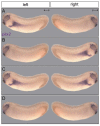Vertebrate Left-Right Asymmetry: What Can Nodal Cascade Gene Expression Patterns Tell Us?
- PMID: 29367579
- PMCID: PMC5872349
- DOI: 10.3390/jcdd5010001
Vertebrate Left-Right Asymmetry: What Can Nodal Cascade Gene Expression Patterns Tell Us?
Abstract
Laterality of inner organs is a wide-spread characteristic of vertebrates and beyond. It is ultimately controlled by the left-asymmetric activation of the Nodal signaling cascade in the lateral plate mesoderm of the neurula stage embryo, which results from a cilia-driven leftward flow of extracellular fluids at the left-right organizer. This scenario is widely accepted for laterality determination in wildtype specimens. Deviations from this norm come in different flavors. At the level of organ morphogenesis, laterality may be inverted (situs inversus) or non-concordant with respect to the main body axis (situs ambiguus or heterotaxia). At the level of Nodal cascade gene activation, expression may be inverted, bilaterally induced, or absent. In a given genetic situation, patterns may be randomized or predominantly lacking laterality (absence or bilateral activation). We propose that the distributions of patterns observed may be indicative of the underlying molecular defects, with randomizations being primarily caused by defects in the flow-generating ciliary set-up, and symmetrical patterns being the result of impaired flow sensing, on the left, the right, or both sides. This prediction, the reasoning of which is detailed in this review, pinpoints functions of genes whose role in laterality determination have remained obscure.
Keywords: Nodal; Nodal cascade; cilia; heterotaxia; left-right asymmetry; left-right organizer; leftward flow; situs ambiguus; situs inversus; symmetry breaking.
Conflict of interest statement
The authors declare no conflict of interest.
Figures


Similar articles
-
PIERCE1 is critical for specification of left-right asymmetry in mice.Sci Rep. 2016 Jun 16;6:27932. doi: 10.1038/srep27932. Sci Rep. 2016. PMID: 27305836 Free PMC article.
-
Left/right patterning signals and the independent regulation of different aspects of situs in the chick embryo.Dev Biol. 1997 Sep 1;189(1):57-67. doi: 10.1006/dbio.1997.8662. Dev Biol. 1997. PMID: 9281337
-
Cilia-driven leftward flow determines laterality in Xenopus.Curr Biol. 2007 Jan 9;17(1):60-6. doi: 10.1016/j.cub.2006.10.067. Curr Biol. 2007. PMID: 17208188
-
[Establishment of visceral left-right asymmetry in mammals: the role of ciliary action and leftward fluid flow in the region of Hensen's node].Ontogenez. 2013 Sep-Oct;44(5):341-56. Ontogenez. 2013. PMID: 25434203 Review. Russian.
-
The Role of Cerl2 in the Establishment of Left-Right Asymmetries during Axis Formation and Heart Development.J Cardiovasc Dev Dis. 2017 Dec 10;4(4):23. doi: 10.3390/jcdd4040023. J Cardiovasc Dev Dis. 2017. PMID: 29367552 Free PMC article. Review.
Cited by
-
Emerging principles of primary cilia dynamics in controlling tissue organization and function.EMBO J. 2023 Nov 2;42(21):e113891. doi: 10.15252/embj.2023113891. Epub 2023 Sep 25. EMBO J. 2023. PMID: 37743763 Free PMC article. Review.
-
How Does the Central Nervous System for Posture and Locomotion Cope With Damage-Induced Neural Asymmetry?Front Syst Neurosci. 2022 Mar 3;16:828532. doi: 10.3389/fnsys.2022.828532. eCollection 2022. Front Syst Neurosci. 2022. PMID: 35308565 Free PMC article. Review.
-
Simulations of particle tracking in the oligociliated mouse node and implications for left-right symmetry-breaking mechanics.Philos Trans R Soc Lond B Biol Sci. 2020 Feb 17;375(1792):20190161. doi: 10.1098/rstb.2019.0161. Epub 2019 Dec 30. Philos Trans R Soc Lond B Biol Sci. 2020. PMID: 31884925 Free PMC article.
-
PACRG is Expressed on the Left Side of the Brain Vesicle in the Ascidian Halocynthia Larva.Dev Reprod. 2024 Dec;28(4):121-128. doi: 10.12717/DR.2024.28.4.121. Epub 2024 Dec 31. Dev Reprod. 2024. PMID: 39845515 Free PMC article.
-
Myosin1G promotes Nodal signaling to control zebrafish left-right asymmetry.Nat Commun. 2024 Aug 2;15(1):6547. doi: 10.1038/s41467-024-50868-y. Nat Commun. 2024. PMID: 39095343 Free PMC article.
References
-
- Dareste C. Recherches sur la Production Artificielle des Monstruosités, ou Essais de Tératogénie Expérimentale. C. Reinwald; Paris, France: 1891.
-
- Fol H., Warynsky S. Sur la production artificielle de l’inversion viscérale ou hétérotaxie chez des embryons de poulet. CR Acad. Sci. Paris. 1883;96:1674–1676.
-
- Campione M., Steinbeisser H., Schweickert A., Deissler K., van Bebber F., Lowe L.A., Nowotschin S., Viebahn C., Haffter P., Kuehn M.R., et al. The homeobox gene Pitx2: Mediator of asymmetric left-right signaling in vertebrate heart and gut looping. Development. 1999;126:1225–1234. - PubMed
Publication types
LinkOut - more resources
Full Text Sources
Other Literature Sources

